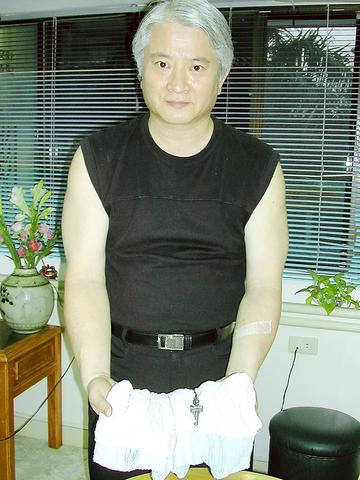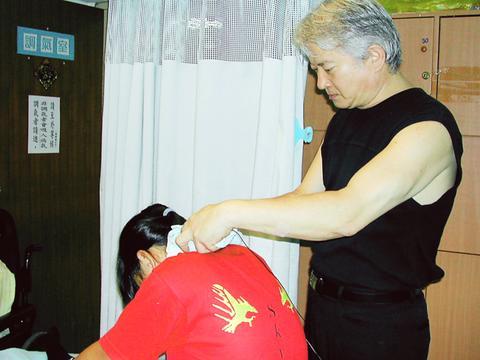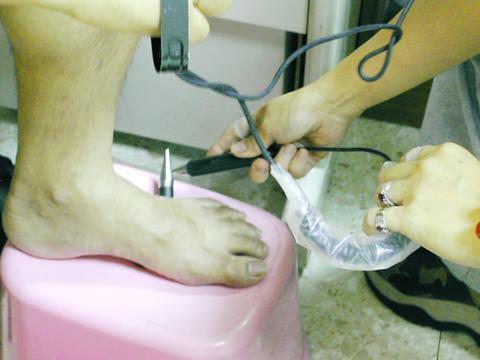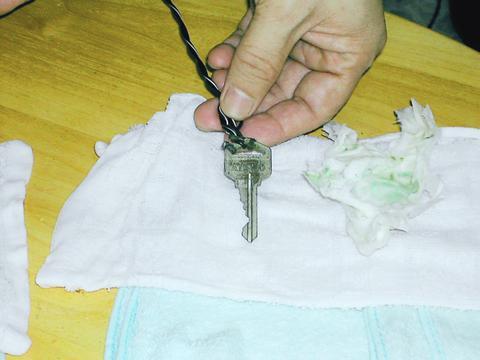The room is bright with a couple of wooden tables and matching chairs. In one corner of the room is a computer that runs a program diagnosing the patients before they enter the room and are treated by Lee Yuan (
Inside the room, a sign reads, "Do stand away from the parameter if you are not here to be treated, or your [sic] will inhale bad qi." Lee, dressed in a gray polo shirt, with his trademark white silky hair, is about to treat Huang Shih-min (
"She used to breathe with noises in her nose, and her nose would often be blocked," said Mrs. Huang, as he daughter awaited treatment.

PHOTO: LISA CHIU
Everything is set and Lee is ready to perform his treatment. He holds two wet towels that are folded in his hands. He begins to unwrap them, revealing two keys wrapped in wet paper towels. The keys are connected to a live wire, which is plugged into the socket right next to the bed.
"See, I wrap them in wet towels because normal people cannot take the current straight from the keys. That's why I wrap them in a towel," Lee says.
The feeling of the electric treatment is like a massager with a spiky surface. It is a bit like touching a refrigerator that is leaking electricity. Lee controls the current through his hands and the qi stored in his stomach controls the power, Lee says.

Ready to treat the girl, he takes a deep breath and looks at ther lying flat on the bed with her two hands folded on her stomach. She seems tense, but lies obediently. Lee uses his body as the medium to transfer the current from the wire to his patients. He claims that he is able to control the current depending on how sick the patients are. He says he has never burned a patient.
Lee says that he practiced conducting electricity on himself hundreds of times before he started treating other people. "More importantly, I have been a vegetarian for more than 20 years. My body is clean and my mind is pure. That's why my patients are safe with me."
Pointing to his ample belly, he says, "Feel how hard my stomach is ...

This is qi."
The wire connected to the keys releases approximately 110 volts. Lee says wrapping them in wet paper towels increases the power 50 times. As Lee holds the towels against the acupuncture points around Huang' s nose, she grimaces but does not cry. When Lee continues to press the towels on her nose for a few second more, however, tears well up in the corner of her eyes.
"These are not tears from pain," Lee says. "Rather they are the essence of the cause of her breathing problems, which is leaving the body. I have cleared the passages by pressing the good qi into her body so that the good qi can begin to help her inner circulation, especially in her nasal area."

Coming from a famous qigong family, Lee began taking lessons from his grandfather when he was four years old. According to Lee, qi means the circulation of blood in the body. If the qi is weak or bad, then diseases often follow, he says.
Electric qigong is based on traditional qigong, which originated in China. In his early 20s, Lee traveled to China, Thailand other countries in South East Asia in search of a master to help him improve his qigong.
He found Lee Ching-hun (
In the first phase of his electric qigong training, Lee burned himself repeatedly, but he persevered. In some of the qigong literature that Lee has published, he says that a human body can accumulate electricity by meditation and qigong exercises.
A human body is also a magnetic field, he says, and if the electricity in the body is weak then the person's magnetic field will also be weak. He says his body acts as a battery charger for his patients.
"I am able to cure my patients because I have been practicing qigong for a long time. I can easily release good qi from my body to my patients," he says. "Using electrical equipment combined with qigong [I can] release the good qi to my patients in order to cure their illness."
On his travels in South East Asia, Lee says he can't recall how many types of herbs, medicines and poisons he tried out to determine their qualities and powers. But, he does know he survived four bouts of malaria and two cases of dengue fever.
He says that he was unconscious for days after eating poisoned mushrooms in Cambodian. "If I hadn't been healthy and hadn't exercised qigong for many years, I would not have lived."
Though Lee has been practicing electric qigong treatment for almost 20 years in South East Asia, it wasn't until two years ago that he began his practice in Taiwan. For the last two years, he's treated patients with minor strokes, chronic pains, paralysis and even patients with tumors and cancers.
Lee says many of his patients will vouch for the efficacy of his treatments. He quotes the case of a paralyzed patient who can now walk again with some assistance; and says doctors confirmed that a tumor had reduced in size because of his treatments with another patient. A young boy confined to a wheelchair can now move his arms and legs after five treatments, Lee says.
Besides conducting electric qigong treatment, Lee promotes qigong by teaching and publishing. "I believe that two brains are better than one," he says. "I hope that by spreading the practice of qigong, I am helping more people to become not only healthier, but also more spiritual."
Lee believes there are some fundamental steps to qigong exercises.
"First of all, you have to release the toxins in your body in order to get rid of illnesses. Then there is meditation, and last, exercising qigong.
"The last thing you want to do is take medicine. If you maintain your health with qigong, you will not need medicine because your body is constantly circulating qi, which is the most important part of maintaining a healthy body," Lee says.
Though seen as an ancient healing alternative, qigong and electric qigong have been adapted by many medical institutions in Germany, says Liu Hung-jen (
Liu says the effectiveness of breathing exercises can be scientifically assessed. "The amount of air you inhale can be measured and monitored as it circulates around the body."
He says modified qigong breathing exercises have been used in western medical treatments to balance the sympathetic nervous system and help patients. "In some cases, doctors have used the breathing technique to deal with anxiety problems."
While Lee's electric qigong treatment is new in Taiwan, it has been practiced in China for many years. Michael Cheung (
"In a material sense it is the same as light, sound or an electromagnetic field. It is a combined electromagnetic field. When a person exercises qi by using the proper techniques, then the radiation can be transformed into energy inside the body," he says. "And a person can only do that when he reaches `qi chi datian,'" [accumulated qi in the lower part of abdomen].
Qi chi datian is most important, Cheung says, adding that once a person is born, he or she is given qi that is stored in the lower part of the abdomen. As a person grows older, the qi in the body begins to leak out. "Without proper techniques to reproduce qi, a man becomes weak and gets sick easily," Cheung says.
He says Lee's electric qigong treatment is like rubbing a piece of iron against a magnet so that it becomes magnetized, and the good qi flows into the patient. But he reserves judgement about the medical effects.
"Electric treatment and qigong exercise are two different stories," Cheung says, believing electric treatment just scratches the surface of the skin and only represses the illness temporarily. "But when you practice qigong, it begins a long-term process that leads to the reorganization of your internal organs."
Cheung says qigong emphasizes meditation, breathing and harmonizing to create a peaceful connection with nature.
"But electricity is artificial. It is not the same as using the power of nature, so it does not last," he concludes.

On April 26, The Lancet published a letter from two doctors at Taichung-based China Medical University Hospital (CMUH) warning that “Taiwan’s Health Care System is on the Brink of Collapse.” The authors said that “Years of policy inaction and mismanagement of resources have led to the National Health Insurance system operating under unsustainable conditions.” The pushback was immediate. Errors in the paper were quickly identified and publicized, to discredit the authors (the hospital apologized). CNA reported that CMUH said the letter described Taiwan in 2021 as having 62 nurses per 10,000 people, when the correct number was 78 nurses per 10,000

As we live longer, our risk of cognitive impairment is increasing. How can we delay the onset of symptoms? Do we have to give up every indulgence or can small changes make a difference? We asked neurologists for tips on how to keep our brains healthy for life. TAKE CARE OF YOUR HEALTH “All of the sensible things that apply to bodily health apply to brain health,” says Suzanne O’Sullivan, a consultant in neurology at the National Hospital for Neurology and Neurosurgery in London, and the author of The Age of Diagnosis. “When you’re 20, you can get away with absolute

When the South Vietnamese capital of Saigon fell to the North Vietnamese forces 50 years ago this week, it prompted a mass exodus of some 2 million people — hundreds of thousands fleeing perilously on small boats across open water to escape the communist regime. Many ultimately settled in Southern California’s Orange County in an area now known as “Little Saigon,” not far from Marine Corps Base Camp Pendleton, where the first refugees were airlifted upon reaching the US. The diaspora now also has significant populations in Virginia, Texas and Washington state, as well as in countries including France and Australia.

May 5 to May 11 What started out as friction between Taiwanese students at Taichung First High School and a Japanese head cook escalated dramatically over the first two weeks of May 1927. It began on April 30 when the cook’s wife knew that lotus starch used in that night’s dinner had rat feces in it, but failed to inform staff until the meal was already prepared. The students believed that her silence was intentional, and filed a complaint. The school’s Japanese administrators sided with the cook’s family, dismissing the students as troublemakers and clamping down on their freedoms — with